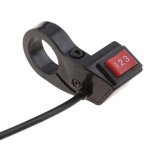Ah. I don't see the word "paired" anywhere in the page, but they do use the word "matched" here:
Disadvantages of Sine Wave E-scooter Controllers
Only compatible with matched motors
I don't know what specifically they're referring to, since they don't discuss this.
My best guess is that it refers to the BEMF waveform of the motor itself, whether it is a sine or trapezoidal waveform. To find out for any particular motor, you need an oscilloscope and a way to manually spin the motor continuously at a particular RPM without running it as a motor (because you want to see the voltage (or current, if you have an electrical load you can place on it) waveform produced by the motor, and not anything fed to it by a controller).
There are some discussions about this type of compatibility here on ES; I don't recall the specific conclusions, except that most common ebike/scooter/etc 3-phase BLDC motors seem to make a sufficiently sinusoidal waveform to work fine with either type of controller, and that there are some rare exceptions that just never run "right" on one or the other type of controller. I didn't find the specific threads for this in a couple-minute search, but they are most likely within the same Motor Technology subforum that this thread is in.
This post has images to compare the two BEMF waveforms
https://endless-sphere.com/forums/viewtopic.php?f=30&t=116326&p=1717179&hilit=sin%2A+trap%2A#p1717130
This one mentions that a sine BEMF motor is less electrically noisy than a trap BEMF motor (which should make it easier for the controller to drive cleanly, I think).
https://endless-sphere.com/forums/viewtopic.php?f=30&t=22232&p=323787&hilit=sin%2A+trap%2A#p323787
Note also that there are (at least) two kinds of sinewave controllers. The cheapest is just like a trap / square controller, except that it uses a lookup table with a sinewave pattern in it instead of trap, to create the motor drive waveforms. It doesn't do anything special, and doesn't need to know anything about the motor to work. "All" (perhaps their are exceptions I haven't seen) of the generic sinewave controllers, plus any combo sine/trap controllers (like those that fallback to trap if sine doesn't work or if halls fail, etc), do it this way. These don't monitor phase currents, just battery current, because they don't need to (the information isn't useful to the controlling process they use), so the waveforms they drive with are voltage waveforms, and their throttles only control the PWM of this waveform, essentially controlling motor speed by controlling average voltage on the motor. Most of these really suck at sensorless startup, or sometimes even low-speed sensorless operation. Most of them also don't support variable regen, just on/off.
The more advanced, more efficient, and "better" way is using FOC or some other variant of motor *current* control that monitors phase currents in the motor and modifies the waveform to drive them based on the results. These use the throttle to control the current to the motor, so they control the torque of the motor, not it's speed (though some of them have options to emulate the speed control instead). Given the right software in them, these can support great sensor less startup from a stop even under high loads, and variable regen braking--even non-regen braking can be done, variably, by forcing controlled reverse currents thru the phases to force the motor to slow down much quicker than a simple regen system can. Whether any particular controller like this does actually do these things well, or at all, depends on the software they run, and how well it is written. THe hardware in them, though, should allow it to be done (assuming sufficient MCU computing power). (this is why you may see OSFW (open source) projects to replace firmware on a popular controller that doesn't do these things with firmware that *does*).
The disadvantage of the more advanced controller to the average non-technical DIYer is that they require specific info about the motor to drive it correctly, and the more advanced the controller is with more options, the more things the user must setup *just right* to make the motor work correctly in their specific application. Some have good autotuning/learning routines; manual tweaking of settings by users even with these isn't that uncommon. Some have insufficient or no autotuning routines, requiring extensive or complete manual setup by the user. (See Sevcon for a prime example of that type).


